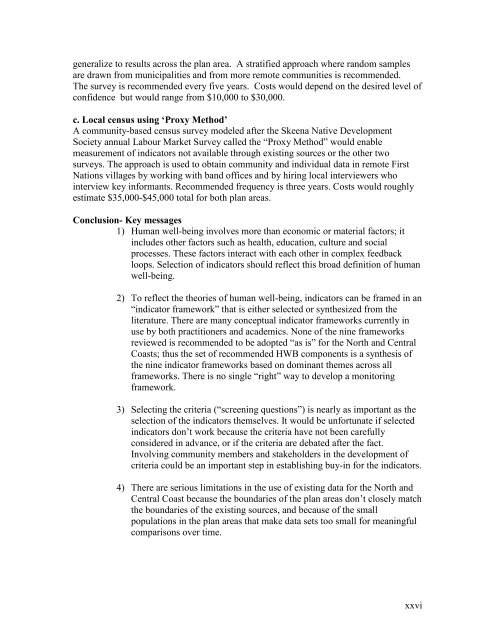Final report - Integrated Land Management Bureau
Final report - Integrated Land Management Bureau
Final report - Integrated Land Management Bureau
You also want an ePaper? Increase the reach of your titles
YUMPU automatically turns print PDFs into web optimized ePapers that Google loves.
generalize to results across the plan area. A stratified approach where random samples<br />
are drawn from municipalities and from more remote communities is recommended.<br />
The survey is recommended every five years. Costs would depend on the desired level of<br />
confidence but would range from $10,000 to $30,000.<br />
c. Local census using ‘Proxy Method’<br />
A community-based census survey modeled after the Skeena Native Development<br />
Society annual Labour Market Survey called the “Proxy Method” would enable<br />
measurement of indicators not available through existing sources or the other two<br />
surveys. The approach is used to obtain community and individual data in remote First<br />
Nations villages by working with band offices and by hiring local interviewers who<br />
interview key informants. Recommended frequency is three years. Costs would roughly<br />
estimate $35,000-$45,000 total for both plan areas.<br />
Conclusion- Key messages<br />
1) Human well-being involves more than economic or material factors; it<br />
includes other factors such as health, education, culture and social<br />
processes. These factors interact with each other in complex feedback<br />
loops. Selection of indicators should reflect this broad definition of human<br />
well-being.<br />
2) To reflect the theories of human well-being, indicators can be framed in an<br />
“indicator framework” that is either selected or synthesized from the<br />
literature. There are many conceptual indicator frameworks currently in<br />
use by both practitioners and academics. None of the nine frameworks<br />
reviewed is recommended to be adopted “as is” for the North and Central<br />
Coasts; thus the set of recommended HWB components is a synthesis of<br />
the nine indicator frameworks based on dominant themes across all<br />
frameworks. There is no single “right” way to develop a monitoring<br />
framework.<br />
3) Selecting the criteria (“screening questions”) is nearly as important as the<br />
selection of the indicators themselves. It would be unfortunate if selected<br />
indicators don’t work because the criteria have not been carefully<br />
considered in advance, or if the criteria are debated after the fact.<br />
Involving community members and stakeholders in the development of<br />
criteria could be an important step in establishing buy-in for the indicators.<br />
4) There are serious limitations in the use of existing data for the North and<br />
Central Coast because the boundaries of the plan areas don’t closely match<br />
the boundaries of the existing sources, and because of the small<br />
populations in the plan areas that make data sets too small for meaningful<br />
comparisons over time.<br />
xxvi
















